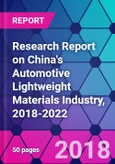Automotive lightweighting refers to reducing an automobile's curb weight as much as possible to achieve comprehensive performance improvement without impairing automobile strength and safety. Automotive lightweighting can be realized by the use of lightweight materials, structure optimization and lightweight molding, of which the use of lightweight materials is the most feasible. Automotive lightweight materials mainly include high strength steels, carbon fiber composites and metal alloys.The Market Size of Automotive Lightweight Materials Will Grow Gradually from 2018 to 2022 and Exceed CNY 300 Billion in 2022
In 2017, the market size of global automotive lightweight materials exceeded USD 100 billion. At present, North America is the world's largest automotive lightweight materials market, followed by Europe. And Asia-Pacific regions including China have the highest growth rate.
China's automotive industry developed rapidly in the past decade. China had been the world's largest auto manufacturer and seller for nine consecutive years from 2009 to 2017. From 2007 to 2017, China's automobile sales increased from 8.79 million units to 28.88 million units. At the end of 2017, the automobile reserves in China reached 217 million units, second only to the U.S. With the rapid development of the automotive industry, automotive lightweighting has become a new trend.
To reduce environment pressure and the reliance on crude oil imports, the Chinese government set the standard for the average fuel consumption of passenger vehicles to promote automotive lightweighting among automobile manufacturers at the policy level. In recent years, the output of China's automotive aluminum alloy castings increased by about 10% every year. As regards to automotive steel sheets, domestic products have almost replaced imports with a market share exceeding 70%. However, China's carbon fiber industry, troubled by backward technologies and low capacity utilization rate, requires a large amount of imports. Automotive lightweight materials are mostly capital and technology intensive industries with high barriers to entry. The raw materials are mainly bulk commodities such as iron ores, non-ferrous metals and crude oil whose prices are susceptible to international supply and demand. At present, the supply of automotive high strength steels in China is highly concentrated in a few giants that master the technologies. The markets of aluminum and magnesium alloys are adequately competitive with a large number of industry players. In the carbon fiber industry, low-end capacity is excessive and the output of high performance products is expected to surge as technical barriers are being broken.
According to the report, in 2015, the average aluminum and magnesium consumption per vehicle in China was 120kg and 1.5kg respectively, representing huge growth potential compared with the global average of 150kg and 5kg respectively. In the context of developing new energy vehicles and reducing fuel consumption, lightweight materials can ensure vehicle safety, reduce curb weight and increase endurance mileage, making them the first choice of automobile manufacturers.
The researcher expects that the market size of automotive lightweight materials will grow gradually from 2018 to 2022 and exceed CNY 300 billion in 2022 with the upgrading of automobile consumption, the increasing importance of lightweight materials to the acceleration, braking and noise control of automobiles, and the higher penetration of lightweight materials in high-end automobiles.
Topics Covered:
- Concept and methods of automotive lightweighting
- Development environment of the automotive lightweight materials industry
- Competition in China's automotive lightweight materials industry
- Major automotive lightweight materials manufacturers in China
- Analysis on production costs and prices of automotive lightweight materials in China
- Driving forces and market opportunities for China's automotive lightweight materials industry
- Forecast on supply of and demand for automotive lightweight materials in China from 2018 to 2022
Table of Contents
Samples

LOADING...
Companies Mentioned
- Baoshan Iron & Steel Co., Ltd.
- Angang Steel Co., Ltd.
- Maanshan Iron & Steel Co., Ltd.
- Guangdong Hongteo Technology Co., Ltd.
- Guangdong Hongtu Technology (Holdings) Co., Ltd.
- Ningbo Xusheng Auto Technology Co., Ltd.
- Chongqing Yujiang Die Casting Co., Ltd.
- CITIC Dicastal Co., Ltd.
- China Zhongwang Holdings Limited
- Jiangsu Asia-Pacific Light Alloy Technology Co., Ltd.
- Novelis Inc
- Yunnan Aluminum Co., Ltd.
- Aleris Corporation
- Jilin Tangu Carbon Fiber Co., Ltd.
- Jiangsu Hengshen Co., Ltd.
- Weihai Guangwei Composites Co., Ltd.
- Toray Industries, Inc.
- Hexcel Corporation
Methodology
Background research defines the range of products and industries, which proposes the key points of the research. Proper classification will help clients understand the industry and products in the report.
Secondhand material research is a necessary way to push the project into fast progress. The analyst always chooses the data source carefully. Most secondhand data they quote is sourced from an authority in a specific industry or public data source from governments, industrial associations, etc. For some new or niche fields, they also "double-check" data sources and logics before they show them to clients.
Primary research is the key to solve questions, which largely influence the research outputs. The analyst may use methods like mathematics, logical reasoning, scenario thinking, to confirm key data and make the data credible.
The data model is an important analysis method. Calculating through data models with different factors weights can guarantee the outputs objective.
The analyst optimizes the following methods and steps in executing research projects and also forms many special information gathering and processing methods.
1. Analyze the life cycle of the industry to understand the development phase and space.
2. Grasp the key indexes evaluating the market to position clients in the market and formulate development plans
3. Economic, political, social and cultural factors
4. Competitors like a mirror that reflects the overall market and also market differences.
5. Inside and outside the industry, upstream and downstream of the industry chain, show inner competitions
6. Proper estimation of the future is good guidance for strategic planning.

LOADING...








